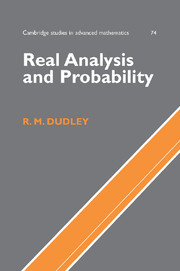Book contents
- Frontmatter
- Contents
- Preface to the Cambridge Edition
- 1 Foundations; Set Theory
- 2 General Topology
- 3 Measures
- 4 Integration
- 5 Lp Spaces; Introduction to Functional Analysis
- 6 Convex Sets and Duality of Normed Spaces
- 7 Measure, Topology, and Differentiation
- 8 Introduction to Probability Theory
- 9 Convergence of Laws and Central Limit Theorems
- 10 Conditional Expectations and Martingales
- 11 Convergence of Laws on Separable Metric Spaces
- 12 Stochastic Processes
- 13 Measurability: Borel Isomorphism and Analytic Sets
- Appendix A Axiomatic Set Theory
- Appendix B Complex Numbers, Vector Spaces, and Taylor's Theorem with Remainder
- Appendix C The Problem of Measure
- Appendix D Rearranging Sums of Nonnegative Terms
- Appendix E Pathologies of Compact Nonmetric Spaces
- Author Index
- Subject Index
- Notation Index
- References
Appendix A - Axiomatic Set Theory
Published online by Cambridge University Press: 06 July 2010
- Frontmatter
- Contents
- Preface to the Cambridge Edition
- 1 Foundations; Set Theory
- 2 General Topology
- 3 Measures
- 4 Integration
- 5 Lp Spaces; Introduction to Functional Analysis
- 6 Convex Sets and Duality of Normed Spaces
- 7 Measure, Topology, and Differentiation
- 8 Introduction to Probability Theory
- 9 Convergence of Laws and Central Limit Theorems
- 10 Conditional Expectations and Martingales
- 11 Convergence of Laws on Separable Metric Spaces
- 12 Stochastic Processes
- 13 Measurability: Borel Isomorphism and Analytic Sets
- Appendix A Axiomatic Set Theory
- Appendix B Complex Numbers, Vector Spaces, and Taylor's Theorem with Remainder
- Appendix C The Problem of Measure
- Appendix D Rearranging Sums of Nonnegative Terms
- Appendix E Pathologies of Compact Nonmetric Spaces
- Author Index
- Subject Index
- Notation Index
- References
Summary
Although more detailed and formal than the presentation in §1.1, this appendix does not claim to provide a complete, rigorous presentation of axiomatic set theory (there are several entire books devoted to the subject, some of them listed in the references). Although axioms for set theory will be stated in detail, some definitions, such as linear ordering and well-ordering, will be assumed to be known (from Chapter 1).
Mathematical Logic
Around 300 b.c., Euclid's geometry presented “a strictly logical deduction of theorems from a set of definitions, postulates and axioms” (Struik, 1948, p. 59). Euclid went a long way, although not all the way, to the modern ideal of the axiomatic method, where, when the proof of a theorem is written out in detail, it can be checked mechanically and precisely to ascertain that it is (or is not) a proof. From a modern point of view, perhaps the least strictly logical part of Euclid's system is his definitions—for example, “a point is that which has no extension,” “a line is a length, without width …” As was noted in §1.1, a truly precise mathematical system, or ‘formal system’, begins with some basic undefined terms. Then other terms can be defined from the basic ones.
The most widely accepted formal systems, giving a foundation for modern mathematics, are based on propositional calculus and first-order predicate logic. Only a very brief introduction to these topics will be given here. For more details see, for example, Kleene (1967).
- Type
- Chapter
- Information
- Real Analysis and Probability , pp. 503 - 520Publisher: Cambridge University PressPrint publication year: 2002



